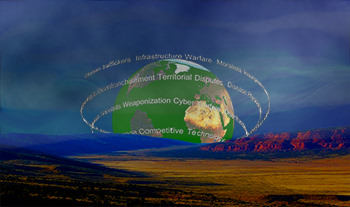Crafty Bastards Workshop - Getting To Green
"I like to see a man proud of the place in which he lives. I like to see a man live so that his place will be proud of him"
~ Abraham Lincoln ~
Current Mission:
Getting To Green: December 4-5, 2014
Current Workshop Library: 
The Need for Systemic Strategic Planning and a Strategic Campaign to Address Violent Islamist Extremism that Manifests Itself in Terrorist Acts
In biology, coevolution is "the change of a biological object triggered by the change of a related object." Coevolution can occur at many biological levels: it can be as microscopic as correlated mutations between amino acids in a protein, or as macroscopic as covarying traits between different species in an environment. Each party in a coevolutionary relationship exerts selective pressures on the other, thereby affecting each other's evolution. Coevolution of different species includes the evolution of a host species and its parasites (host–parasite coevolution), and examples of mutualism evolving through time. Evolution in response to abiotic factors, such as climate change, is not biological coevolution (since climate is not alive and does not undergo biological evolution). The general conclusion is that coevolution may be responsible for much of the genetic diversity seen in normal populations including: blood plasma polymorphism, protein polymorphism, histocompatibility systems, etc.
In this mutualistic symbiotic relationship, the yucca plant (Yucca whipplei) is pollinated exclusively by Tegeticula maculata, a species of yucca moth that in turn relies on the yucca for survival. Yucca moths tend to visit the flowers of only one species of yucca plant. In the flowers, the moth eats the seeds of the plant, while at the same time gathering pollen on special mouth parts. The pollen is very sticky, and will easily remain on the mouth parts when the moth moves to the next flower. The yucca plant also provides a place for the moth to lay its eggs, deep within the flower where they are protected from any potential predators. The adaptations that both species exhibit characterize coevolution because the species have evolved to become dependent on each other.
One of the most important parts of an organism's environment is other organisms. Co-evolution occurs when, in adapting to their environments, two or more organisms evolve together. To "make the best of" where they live, organisms make use of other organisms by eating them, living on or in them, and/or building a "partnership" with them. Organisms co-evolve with many species at the same time, because an environment includes many different types of organisms.
Organisms have to adapt to form these relationships just as they have to adapt to any other part of their environments. These adaptations cause so much change that descendants, who are better suited to take advantage of the relationship, are so different that they may be an entirely different species from their ancestors.
It is important to note that species that are closely related did not always appear at the same time. For example, although the first mammals appeared approximately 225 million to 180 million years ago, not all mammal species appeared at that time. This is especially important to realize in the case of co-evolution. Organisms have co-evolved whose families first appeared very far apart on evolution's time scale. For example, the first segmented flatworms originated millions of years before the first mammals. However, the tapeworm, a segmented flatworm that is a parasite of humans, cows, and other mammals, could not have evolved before the first large mammals, because it adapted so much to the parasitic relationship that its ancestors before the relationship were not of the same species of worm. Relationships formed through co-evolution may be called symbiotic relationships. Three types of symbiotic relationships are predator-prey relationships, mutualistic relationships, and parasitic relationships.
Evolutionary game theory originated as an application of the mathematical theory of games to biological contexts, arising from the realization that frequency dependent fitness introduces a strategic aspect to evolution. Recently, however, evolutionary game theory has become of increased interest to economists, sociologists, and anthropologists--and social scientists in general--as well as philosophers. The interest among social scientists in a theory with explicit biological roots derives from three facts. First, the ‘evolution’ treated by evolutionary game theory need not be biological evolution. ‘Evolution’ may, in this context, often be understood as cultural evolution, where this refers to changes in beliefs and norms over time. Second, the rationality assumptions underlying evolutionary game theory are, in many cases, more appropriate for the modelling of social systems than those assumptions underlying the traditional theory of games. Third, evolutionary game theory, as an explicitly dynamic theory, provides an important element missing from the traditional theory. In the preface to Evolution and the Theory of Games, Maynard Smith notes that “[p]aradoxically, it has turned out that game theory is more readily applied to biology than to the field of economic behaviour for which it was originally designed.” It is perhaps doubly paradoxical, then, that the subsequent development of evolutionary game theory has produced a theory which holds great promise for social scientists, and is as readily applied to the field of economic behaviour as that for which it was originally designed.
A simple short video explanation of how coevolution works (including what it is and what it is not). This explanation introduces the concepts of “arms races” and the coevolution of humans and technology (a topic addressed in great detail in What Technology Wants, by Kevin Kelly, Viking Books, NY, 2010)
In philosophy, systems theory, science, and art, emergence is conceived as a process whereby larger entities, patterns, and regularities arise through interactions among smaller or simpler entities that themselves do not exhibit such properties. In philosophy, almost all accounts of emergence include a form of irreducibility (either epistemic or ontological) to the lower levels.[1] Also, emergence is central in theories of integrative levels and of complex systems. For instance, the phenomenon life as studied in biology is commonly perceived as an emergent property of interacting molecules as studied in chemistry, whose phenomena reflect interactions among elementary particles, modeled in particle physics, that at such higher mass—via substantial conglomeration—exhibit motion as modeled in gravitational physics. Neurobiological phenomena are often presumed to suffice as the underlying basis of psychological phenomena, whereby economic phenomena are in turn presumed to principally emerge.
If we were pressed to give a definition of emergence, we could say that a property is emergent if it is a novel property of a system or an entity that arises when that system or entity has reached a certain level of complexity and that, even though it exists only insofar as the system or entity exists, it is distinct from the properties of the parts of the system from which it emerges. However, as will become apparent, things are not so simple because “emergence” is a term used in different ways both in science and in philosophy, and how it is to be defined is a substantive question in itself.
In describing collective behaviors, emergence refers to how collective properties arise from the properties of parts, how behavior at a larger scale arises from the detailed structure, behavior and relationships at a finer scale. For example, cells that make up a muscle display the emergent property of working together to produce the muscle's overall structure and movement. A water molecule has emergent properties that arise out of the properties of oxygen and hydrogen atoms. Many water molecules together form river flows and ocean waves. Trees, other plants and animals form a forest.
Emergence is a notorious philosophical term of art. A variety of theorists have appropriated it for their purposes ever since George Henry Lewes gave it a philosophical sense in his 1875 Problems of Life and Mind. We might roughly characterize the shared meaning thus: emergent entities (properties or substances) ‘arise’ out of more fundamental entities and yet are ‘novel’ or ‘irreducible’ with respect to them. (For example, it is sometimes said that consciousness is an emergent property of the brain.) Each of the quoted terms is slippery in its own right, and their specifications yield the varied notions of emergence that we discuss below. There has been renewed interest in emergence within discussions of the behavior of complex systems and debates over the reconcilability of mental causation, intentionality, or consciousness with physicalism.
A multimedia presentation on different forms of emergence, including human life and the arts (includes an example similar to John Conway’s “Game of Life,” referred to in some of the below texts)
in Sweden: Innovation policy for exploring the adjacent possible.
This 2011 paper covers in depth the concepts of the Adjacent Possible as conceptually pioneered by Stuart Kauffman (participant in the G2G Workshop). The paper defines in detail the properties and applications of complexity science and the development of organizations, niche products and technologies, and policy that leverages thinking in terms of the Adjacent Possible. It also presents several important graphics and tables that support its narrative. This paper seeks to demonstrate how we search landscapes for solutions by integrating the abilities of the searching agents (typically humans) and what the environment offers through exploratory techniques that leverage Kauffman’s articulation of the Adjacent Possible. In sum, this paper demonstrates what is intellectually possible when thinking in terms of the Adjacent Possible.
The west has lost the power to shape the world in its own image – as recent events, from Ukraine to Iraq, make all too clear. So why does it still preach the pernicious myth that every society must evolve along western lines?
 KGH Capability Statement
KGH Capability Statement
